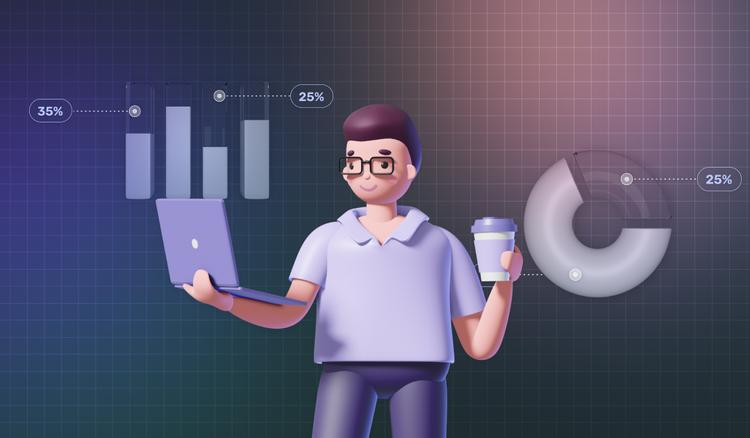Give us a quick overview on SolveIt. When and how did you begin this journey and what were your motives to be successful in app development?
Our journey started small in scale, I was a developer and already knew everything inside out. More projects came up, clients liked our approach to business and the quality of our services. I gathered a team of the most experienced developers and founded SolveIt. Initially, we were only doing mobile apps, now we have a team of 51 professionals and 18 services to effectively solve customer problems.
What is your role in the management and development of SolveIt? As a CEO and Founder at SolveIt, I am responsible for crucial decisions, long-term development strategies, and the company’s overall performance.
Tell us about your biggest achievement in the industry
I believe the biggest achievement for our company and for me personally is that along the way our clients stop being clients and become our friends, and that’s something you can’t put a price on. We still communicate with all of our clients and the retention rate is more than 85%. They don’t just come back for software development and support, but for product launch and promotion.
How do you schedule the development phases of the apps to promise the timeline to your clients?
If you look at a high-level project, we usually distinguish between stages: specification/design; development; testing and QA and launch. We actively use Agile and Scrum methodologies for projects. By dividing the project into small iterations (2-week sprints) we ensure a controlled project development process. We pride ourselves in knowing that our clients always know what the team is working on and when the next version of the application will be released. It ensures high customer involvement. With every milestone we report to the client, gain their valuable feedback, and act upon it before taking up the next task. Our focus on quality and a transparent iterative work model has built confidence in us as a strategic and long-term technology partner.
How do you help your clients in choosing the right yet profitable platform for app development?
On each project, we try to fully understand the business processes, the specifics of the subject matter and plans for the project’s development. After that, we give recommendations to the client based on our experience and expertise about how to proceed with their launch.
Which would you suggest for a successful and profitable business progression, Native or hybrid apps? How do you define the factors that influenced you to make this choice?
Each of these approaches has its own pros and cons. Hybrid development works best for projects where it is important to be cost-effective and quickly implement new features. However, Hybrid development has a number of drawbacks, in particular, it is less supported and when new versions of Android and IOS are released, the application can be unstable. Native development, in turn, is much more stable, the application runs smoother and there are many more possibilities for making complex animations and UI elements. The disadvantages of native development can be attributed to the high price due to the fact that each platform needs to be developed separately, and in this regard, the speed and cost of introducing new functionality is higher.
How do you scheme your pricing model? How do you fix your budget?
We work on three different engagement models: Time&Material, which means that at the start of the project, we work on pre-estimation and carry out work in sprints with preliminary approval of the scope of work and tasks performed. Payment is made based on the hours worked in the reporting period (2-4 weeks). This model lets you maintain the flexibility of the project and its functionality. Each stage of planning the next sprint, its content, and user-stories will be approved by our customer. Then there's the Fixed Price model. We estimate the project and its parts and fix the cost. Until the first stage is completed, the next stage does not start. Payment, timeframes, and the scope of work are fixed and are specified in the contract. A contract with a fixed price is most often used for small projects with strictly limited functionality, which will definitely not be changed or supplemented. Finally, we offer the ability to use us as an Offshore Development Centre or Offshore Dedicated Team if you will. This kind of operation is a perfect solution for businesses wishing to augment their software development productivity without bearing too much additional expenses such as hiring extra staff or investing in other resources.
First, we conduct several interviews with the client and form a commercial proposal, where we show him all the options and our team offers the best way for the customer to develop and evaluate the project based on the requirements.
How helpful are the mobile apps developed by your team, for enhancing your clients’ business?
Each mobile application is unique and useful. We make the product as usable as possible through design, high-quality development and strict testing. Our products have 1M+ end-users worldwide and help clients increase profits and customer loyalty, and open additional paths of monetization for their business.
What according to you are the best practices to attain client satisfaction?
The best practices to attain client satisfaction are:
- Responsible work approach
- Transparent reports
- Support client’s product during and after development
- High quality for a good price
- Finding an individual approach to each client
How do you update your business system to be in pace with the technological advancements?
I think IT companies have to keep up with technological progress. We actively work with existing customers and offer them the ability to implement innovative solutions, improving their products. We also develop new products, constantly monitoring for technological advancements.
What are your thoughts about AR, VR and Internet of Things (IoT)?
AR, VR, IoT are actively developing areas now and according to analytics and investments in this area still have huge potential for explosive growth. The current market has many industries that are yet to disintegrate into smaller sub-sectors. In the foreseeable future, these technologies will be in the home of every human being on the planet and become an integral part of our lives as the Internet has become nowadays. We as a company are staying on top of it and are developing these areas by introducing advanced developments, frameworks, libraries and methodologies.
What do you think will be the future of Mobile technology?
Every year Google and Apple present new versions of their operating systems which are closer and closer to the features provided by desktop platforms, and sometimes even superior. Qualcomm, Mediatek, Exynos (Samsung) continually update the line of processors constantly raising the bar of performance and energy efficiency, which together with the OS makes for a great user experience. More and more often I, as well as I think you, can see that phones handle a large part of our interactions with the Internet. In line with this vision, we as a company see a great demand from society to innovate and create products on mobile platforms and this demand will increase more and more as it becomes an integral part of our lives.

![IOS and Android development: what to choose? [overview, benefits, challenges, costs]](/_next/image?url=https%3A%2F%2Fsolveit.dev%2Frails%2Factive_storage%2Fblobs%2FeyJfcmFpbHMiOnsibWVzc2FnZSI6IkJBaHBBamNGIiwiZXhwIjpudWxsLCJwdXIiOiJibG9iX2lkIn19--a43e516190d493dbddb660851612261f074405cc%2Fcover2%2520IOS%2520and%2520Android-min.jpg&w=750&q=75)
![How to create a fitness app: complete development guide [steps, features, costs]](/_next/image?url=https%3A%2F%2Fsolveit.dev%2Frails%2Factive_storage%2Fblobs%2FeyJfcmFpbHMiOnsibWVzc2FnZSI6IkJBaHBBaVlDIiwiZXhwIjpudWxsLCJwdXIiOiJibG9iX2lkIn19--f4f49625f7b386f020ef279402f1313a6711742a%2FHow%2520to%2520build%2520a%2520fitness%2520app1-min.jpg&w=750&q=75)
